Related Research Articles
Antisemitism is hostility to, prejudice towards, or discrimination against Jews. A person who holds such positions is called an antisemite. Antisemitism is considered to be a form of racism.

The yellow badge, also known as yellow patch, Jewish badge or yellow star, was a badge that Jews were ordered to wear by some caliphates during the Middle Ages, some European powers during the Medieval and early modern periods, and the Axis powers in World War II. The badges marked the wearer as a religious or ethnic outsider, often as a badge of shame.
Tzniut describes the character trait of modesty and discretion, as well as a group of Jewish laws pertaining to conduct. The concept is most important within Orthodox Judaism.
"Who is a Jew?" is a basic question about Jewish identity and considerations of Jewish self-identification. The question pertains to ideas about Jewish personhood, which have cultural, ethnic, religious, political, genealogical, and personal dimensions. Orthodox Judaism and Conservative Judaism follow Jewish law (Halakha), deeming people to be Jewish if their mothers are Jewish or if they underwent a halakhic conversion. Reform Judaism and Reconstructionist Judaism accept both matrilineal and patrilineal descent as well as conversion. Karaite Judaism predominantly follows patrilineal descent as well as conversion.

The history of the Jews in Denmark goes back to the 1600s. At present, the Jewish community of Denmark constitutes a small minority of about 6,000 persons within Danish society. The community's population peaked prior to the Holocaust at which time the Danish resistance movement took part in a collective effort to evacuate about 8,000 Jews and their families from Denmark by sea to nearby neutral Sweden, an act which ensured the safety of almost all the Danish Jews.

A badge of shame, also a symbol of shame, a mark of shame or a stigma, is typically a distinctive symbol required to be worn by a specific group or an individual for the purpose of public humiliation, ostracism or persecution.
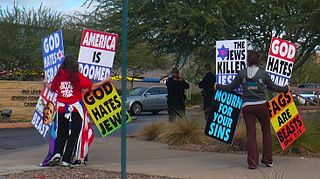
Antisemitism in the United States has existed for centuries. In the United States, most Jewish community relations agencies draw distinctions between antisemitism, which is measured in terms of attitudes and behaviors, and the security and status of American Jews, which are both measured by the occurrence of specific incidents. FBI data shows that in every year since 1991, Jews were the most frequent victims of religiously motivated hate crimes, according to a report which was published by the Anti-Defamation League in 2019. Evidence suggests that the true number of hate crimes against Jews is underreported, as is the case for many other targeted groups.
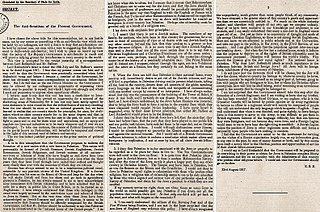
Anti-Zionism is opposition to Zionism. Although anti-Zionism is a heterogeneous phenomenon, all its proponents agree that the creation of the modern State of Israel, and the movement to create a sovereign Jewish state in the region of Palestine – the biblical Land of Israel – was flawed or unjust in some way.
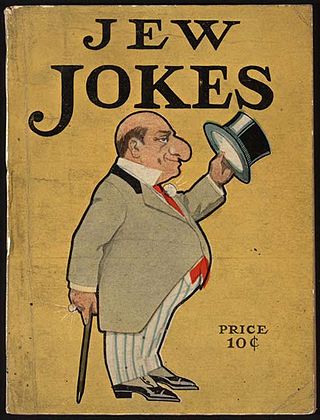
Stereotypes of Jews are generalized representations of Jews, often caricatured and of a prejudiced and antisemitic nature.
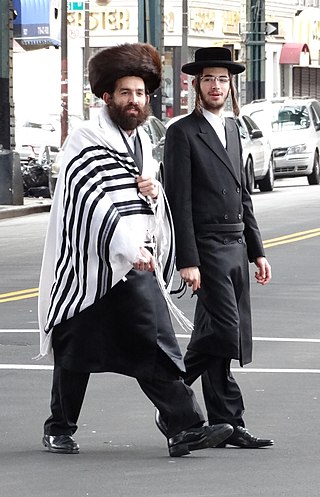
Jewish religious clothing is apparel worn by Jews in connection with the practice of the Jewish religion. Jewish religious clothing has changed over time while maintaining the influences of biblical commandments and Jewish religious law regarding clothing and modesty (tzniut). Contemporary styles in the wider culture also have a bearing on Jewish religious clothing, although this extent is limited.
Stereotypes of Jews in literature have evolved over the centuries. According to Louis Harap, nearly all European writers prior to the twentieth century projected the Jewish stereotypes in their works. Harap cites Gotthold Lessing's Nathan the Wise (1779) as the first time that Jews were portrayed in the arts as "human beings, with human possibilities and characteristics." Harap writes that, the persistence of the Jewish stereotype over the centuries suggests to some that "the treatment of the Jew in literature was completely static and was essentially unaffected by the changes in the Jewish situation in society as that society itself changed." He contrasts the opposing views presented in the two most comprehensive studies of the Jew in English literature, one by Montagu Frank Modder and the other by Edgar Rosenberg. Modder asserts that writers invariably "reflect the attitude of contemporary society in their presentation of the Jewish character, and that the portrayal changes with the economic and social changes of each decade." In opposition to Modder's "historical rationale", Rosenberg warns that such a perspective "is apt to slight the massive durability of a stereotype". Harap suggests that the recurrence of the Jewish stereotype in literature is itself one indicator of the continued presence of anti-Semitism amongst the readers of that literature.
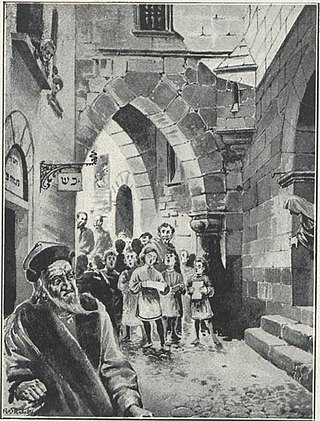
Antisemitism in Spain has its roots in Christian anti-Judaism which began with the expansion of Christianity on the Iberian Peninsula during the rule of the Roman Empire. Its first violent manifestation occurred in the brutal persecution of Jews in Visigothic Hispania. During the Middle Ages, Jews in Islamic-occupied Spain, Al-Andalus, were designated as dhimmis, and, despite occasional violent outbursts such as the 1066 Granada massacre, they were granted protection to profess their religion in exchange of abiding to certain conditions that limited their rights in relation to Muslims. After the Almoravid invasion in the 11th century, the situation of the Jewish population in Muslim territory worsened, and during the Almohad invasion of the peninsula, many Jews fled to the northern Christian kingdoms, the eastern Mediterranean and the more tolerant Muslim areas in North Africa.
Belgium is a European country with a Jewish population of approximately 35,000 out of a total population of about 11.4 million. It is among the countries experiencing an increase in both antisemitic attitudes and in physical attacks on Jews.
Ashkenormativity refers to a form of Eurocentrism within Ashkenazi Jewish culture that confers privilege on Ashkenazi Jews relative to Jews of Sephardi, Mizrahi, and other non-Ashkenazi backgrounds, as well as to the assumption that Ashkenazi culture is the default Jewish culture. Ashkenormativity often overlaps with white privilege, as many Ashkenazi Jews are white, but the terms are not synonymous as Ashkenazi Jews of color do not benefit from white privilege and some non-Ashkenazi Jews, such as white Sephardi or white Mizrahi Jews, may benefit from white privilege. The term is most commonly used in the United States, where the majority of Jews are Ashkenazi. Ashkenormativity is also alleged to exist in Israel, where Ashkenazi Jews experience cultural prominence despite no longer constituting a majority.

Jewface is a term that negatively characterizes stereotypical or inauthentic portrayals of Jewish people. The term has existed since the late 1800s, and most generally refers to performative Jewishness, regardless of the performer's identity.
Black Jews in New York City comprise one of the largest communities of Black Jews in the United States. Black Jews have lived in New York City since colonial times, with organized Black-Jewish and Black Hebrew Israelite communities emerging during the early 20th century. Black Jewish and Black Hebrew Israelite communities have historically been centered in Harlem, Brooklyn, The Bronx, and Queens. The Commandment Keepers movement originated in Harlem, while the Black Orthodox Jewish community is centered in Brooklyn. New York City is home to four historically Black synagogues with roots in the Black Hebrew Israelite community. A small Beta Israel (Ethiopian-Jewish) community also exists in New York City, many of whom emigrated from Israel. Black Hebrew Israelites are not considered Jewish by the New York Board of Rabbis, an organization representing mainstream Rabbinic Judaism.
Racism in Jewish communities is a source of concern for people of color, particularly for Jews of color. Black Jews, Indigenous Jews, and other Jews of color report that racism is practiced by white Jews in many countries, including the United States, Canada, the United Kingdom, France, Kenya, South Africa, and New Zealand. Sephardi and Mizrahi Jews also report experiences with racism by Ashkenazi Jews. The centering of Ashkenazi Jews is sometimes known as Ashkenormativity. In historically white-dominated countries with a legacy of anti-Black racism, such as the United States and South Africa, racism within the Jewish community often manifests itself as anti-Blackness. In Israel, racism among Israeli Jews often manifests itself as discrimination and prejudice against Sephardi and Mizrahi Jews, Ethiopian Jews, African immigrants, and Palestinians.
The Scattered Nation is a philosemitic and racist speech by the U.S. Senator, Confederate officer, and slaveowner Zebulon Baird Vance, written sometime between 1868 and 1870. The speech praises the accomplishments of Jewish people, crediting Jews for much of what Vance considered great in Western civilization. Particular praise in reserved for white Jews of Central and Western European descent, while Black people and Jews of color are disparaged as culturally and racially inferior. Vance was a prominent defender of Jews during a time when antisemitism was common in the American South. While positively remembered for decades by the North Carolina Jewish community, Vance's reputation has declined in recent years due to his racism, support for slavery and the Confederacy, and promotion of Jewish stereotypes.
Jews of color is a neologism, primarily used in North America, that describes Jews from diverse racial and ethnic backgrounds, whether biracial, adopted, Jews by choice, or part of other national or geographic populations. It is often used to identify Jews who are racially non-white, whose family origins are originally in African, Asian or Latin American countries, and to acknowledge a common experience for Jews who belong to racial, national, or geographic groups beyond white and Ashkenazi.
Zionist antisemitism is the phenomenon in which individuals, groups, or governments support the Zionist movement and the State of Israel while they simultaneously hold antisemitic views about Jews. In some cases, Zionism may be promoted for explicitly antisemitic reasons. The prevalence of antisemitism has been widely noted within the Christian Zionist movement, whose adherents may hold antisemitic and supersessionist beliefs about Jews while also supporting Zionism for eschatological reasons. Antisemitic right-wing nationalists, particularly in Europe and the United States, sometimes support the Zionist movement because they wish that Jews be expelled or that they emigrate to Israel. The Israeli government's alleged collaboration with antisemitic politicians abroad has been criticized as an example of Zionist antisemitism. Anti-Zionists have criticized the Zionist movement for its alleged complicity with or its alleged capitulation to antisemitism since its inception, with some anti-Zionists also referring to Zionism as a form of antisemitism.
References
- ↑ Stack, Liam (17 February 2020). ""Most Visible Jews" Fear Being Targets as Anti-Semitism Rises". The New York Times . Retrieved 2021-12-17.
- ↑ "Bay Area Jews ask: Should our buildings be visibly Jewish?". J. The Jewish News of Northern California. 13 October 2021. Retrieved 2021-12-17.
- ↑ "Invisible Jews: Does internalized anti-Semitism play a role in unaddressed Jewish poverty in America?". Smith College . Retrieved 2021-12-17.
- 1 2 "How many Jews of color are there? Fewer than you think". The Forward. 18 May 2020. Retrieved 2021-12-17.
- ↑ "Anti-Jewish Hate Crimes Have Nothing to Do With Our Religion". Jewcy . Retrieved 2021-12-17.
- ↑ "Revealing Jews: Culture and Visibility in Modern Central Europe" (PDF). Purdue University . Retrieved 2023-02-18.
- ↑ "Too Goyish". Canadian Jewish News. 19 December 2022. Retrieved 2023-02-18.
- ↑ "Rabbi Streiffer: There is no such thing as looking Jewish". Canadian Jewish News. 10 January 2020. Retrieved 2023-02-18.
- ↑ "Almost Half of Young U.S. Jews Feel No Connection to Religion, New Pew Survey Shows". Haaretz . Retrieved 2021-12-17.
- ↑ "Our Response to Recent Incidents of Antisemitism in New York". UJA-Federation of New York . Retrieved 2021-12-17.
- ↑ "HIDDEN CHILDREN: HARDSHIPS". Holocaust Encyclopedia . Retrieved 2021-12-17.
- ↑ "Jewish visibility". The Jerusalem Post . Retrieved 2021-12-17.
- ↑ "The Day: The cost of being visibly Jewish in Germany". Deutsche Welle . Retrieved 2021-12-17.
- ↑ "The Jewish man who was the victim of a gang assault in New York says the level of hatred was troubling". CNN. 22 May 2021. Retrieved 2021-12-17.
- ↑ "On visible and invisible Jews". Columbus Jewish News. Retrieved 2021-12-17.